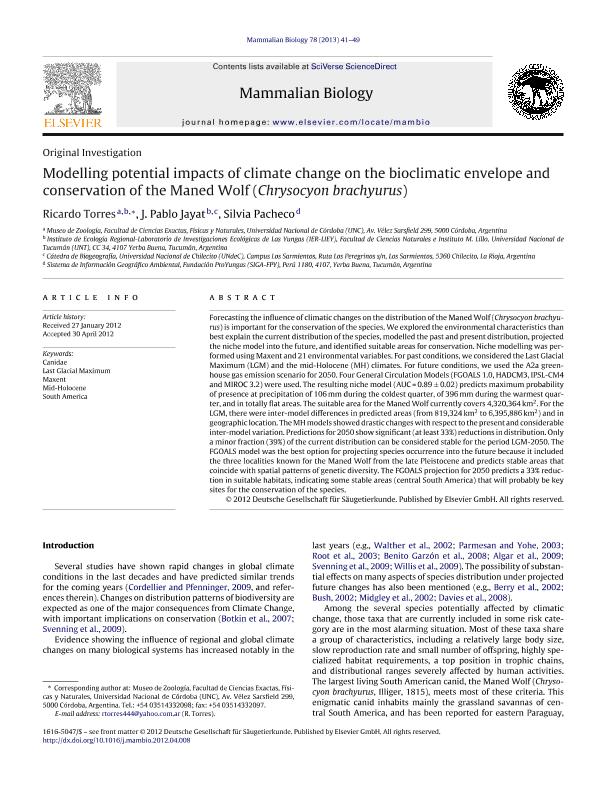Mostrar el registro sencillo del ítem
dc.contributor.author
Torres, Ricardo Marcelo

dc.contributor.author
Jayat, Jorge Pablo

dc.contributor.author
Pacheco, Silvia

dc.date.available
2017-09-12T20:20:59Z
dc.date.issued
2012-06
dc.identifier.citation
Torres, Ricardo Marcelo; Jayat, Jorge Pablo; Pacheco, Silvia; Modelling potential impacts of climate change on the bioclimatic envelope and conservation of the Maned Wolf (Chrysocyon brachyurus); Elsevier; Mammalian Biology; 78; 1; 6-2012; 41-49
dc.identifier.issn
1616-5047
dc.identifier.uri
http://hdl.handle.net/11336/24091
dc.description.abstract
Forecasting the influence of climatic changes on the distribution of the Maned Wolf (Chrysocyon brachyurus) is important for the conservation of the species. We explored the environmental characteristics than best explain the current distribution of the species, modelled the past and present distribution, projected the niche model into the future, and identified suitable areas for conservation. Niche modelling was performed using Maxent and 21 environmental variables. For past conditions, we considered the Last Glacial Maximum (LGM) and the mid-Holocene (MH) climates. For future conditions, we used the A2a greenhouse gas emission scenario for 2050. Four General Circulation Models (FGOALS 1.0, HADCM3, IPSL-CM4 and MIROC 3.2) were used. The resulting niche model (AUC = 0.89 ± 0.02) predicts maximum probability of presence at precipitation of 106 mm during the coldest quarter, of 396 mm during the warmest quarter, and in totally flat areas. The suitable area for the Maned Wolf currently covers 4,320,364 km2. For the LGM, there were inter-model differences in predicted areas (from 819,324 km2 to 6,395,886 km2) and in geographic location. The MH models showed drastic changes with respect to the present and considerable inter-model variation. Predictions for 2050 show significant (at least 33%) reductions in distribution. Only a minor fraction (39%) of the current distribution can be considered stable for the period LGM-2050. The FGOALS model was the best option for projecting species occurrence into the future because it included the three localities known for the Maned Wolf from the late Pleistocene and predicts stable areas that coincide with spatial patterns of genetic diversity. The FGOALS projection for 2050 predicts a 33% reduction in suitable habitats, indicating some stable areas (central South America) that will probably be key sites for the conservation of the species.
dc.format
application/pdf
dc.language.iso
eng
dc.publisher
Elsevier

dc.rights
info:eu-repo/semantics/openAccess
dc.rights.uri
https://creativecommons.org/licenses/by-nc-sa/2.5/ar/
dc.subject
Canidae
dc.subject
Last Glacial Maximum
dc.subject
Maxent
dc.subject
Mid-Holocene
dc.subject
South America
dc.subject.classification
Bioquímica y Biología Molecular

dc.subject.classification
Ciencias Biológicas

dc.subject.classification
CIENCIAS NATURALES Y EXACTAS

dc.title
Modelling potential impacts of climate change on the bioclimatic envelope and conservation of the Maned Wolf (Chrysocyon brachyurus)
dc.type
info:eu-repo/semantics/article
dc.type
info:ar-repo/semantics/artículo
dc.type
info:eu-repo/semantics/publishedVersion
dc.date.updated
2017-09-12T16:29:56Z
dc.journal.volume
78
dc.journal.number
1
dc.journal.pagination
41-49
dc.journal.pais
Alemania

dc.journal.ciudad
Munich
dc.description.fil
Fil: Torres, Ricardo Marcelo. Universidad Nacional de Córdoba. Facultad de Ciencias Exactas, Físicas y Naturales. Museo de Zoología; Argentina. Universidad Nacional de Tucumán. Facultad de Ciencias Naturales e Instituto Miguel Lillo. Laboratorio de Investigaciones Ecológicas de las Yungas; Argentina
dc.description.fil
Fil: Jayat, Jorge Pablo. Universidad Nacional de Tucumán. Facultad de Ciencias Naturales e Instituto Miguel Lillo. Laboratorio de Investigaciones Ecológicas de las Yungas; Argentina. Universidad Nacional de Chilecito; Argentina. Consejo Nacional de Investigaciones Científicas y Técnicas; Argentina
dc.description.fil
Fil: Pacheco, Silvia. Fundación ProYungas. Sistema de Información Geográfico Ambiental; Argentina
dc.journal.title
Mammalian Biology

dc.relation.alternativeid
info:eu-repo/semantics/altIdentifier/url/http://www.sciencedirect.com/science/article/pii/S1616504712000626
dc.relation.alternativeid
info:eu-repo/semantics/altIdentifier/doi/http://dx.doi.org/10.1016/j.mambio.2012.04.008
Archivos asociados
